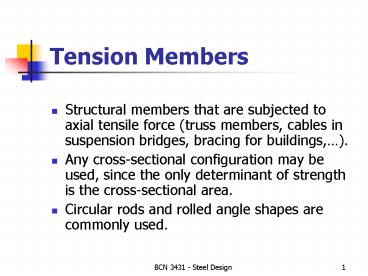Tension Members PowerPoint PPT Presentation
1 / 16
Title: Tension Members
1
Tension Members
- Structural members that are subjected to axial
tensile force (truss members, cables in
suspension bridges, bracing for buildings,). - Any cross-sectional configuration may be used,
since the only determinant of strength is the
cross-sectional area. - Circular rods and rolled angle shapes are
commonly used.
2
Gross and Net Areas
- The usual practice is to drill or punch standard
holes with a diameter 1/16 in. larger than the
fastener diameter. - To account for possible roughness around the
edges of the hole, AISC requires the addition of
1/16 in. to the actual hole diameter. - Thus, the effective hole diameter is 1/8 in.
larger than the fastener diameter.
3
Example
- Ag 5 x ½ 2.5 in2
- An (5-2 x ¾) x ½ 1.75 in2
4
Design Strength
- A tension member can fail by reaching one of the
two limiting states yielding or fracture. - To prevent yielding and accompanying excessive
deformation, the stress on the gross section(Ag )
should be less than Fy . - To prevent fracture, the stress on the net
section(An) must be less than Fu.
5
Nominal Strength
- Nominal strength in yielding, Pn
Fy Ag - Nominal strength in fracture, Pn
Fu Ae - Ae is the effective net area. The smaller of
these is the design strength of the member.
6
Strength Reduction Factor
- Strength reduction factor for yielding,
?t 0.90 - Strength reduction factor for failure,
?t 0.75 - The resistance factor is smaller for fracture
than yielding, reflecting the more serious nature
of reaching the limit state of fracture.
7
Effective Net Area
- When all elements of the cross section are not
connected ( Ex only one leg of an angle is
bolted to a gusset plate), shear lag occurs. - The connected element becomes overloaded and the
unconnected part is not fully stressed. - This can be accounted for by using a reduced, or
effective, net area.
8
Effective Net Area
- For Bolted Connections Ae
U An - If all elements of the cross section are
connected, then, U 1 - If not, use the recommended values of the
reduction factor, U (see next slide)
9
Recommended Values for U
10
Effective Net Area
- For welded connections
Ae U Ag - For any W-, M-, S-, or tee shape connected by
transverse weld alone
Ae area of connected element
11
(No Transcript)
12
Ae For Welded Connections
- For plates or bars connected by longitudinal
welds at their ends - U1 l ? 2w
- U0.87 2w ? l ? 1.5w
- U0.75 1.5w ? l ? w
- l length of the pair of welds ? w
- w distance between the welds
13
Staggered Fasteners
- The net area will be maximized if the fasteners
are placed in a single line. - If more than one line is needed (limited
connection length), staggering the fasteners
minimizes the reduction in cross-sectional area.
14
Staggered Fasteners
- wn wg ? d ? s2 / 4g
- wn net width
- wg gross width
- ? d sum of the hole diameters
- s (pitch) spacing of two adjacent holes (
parallel to direction of the load) - g (gage) transverse spacing of lines of bolts
15
(No Transcript)
16
Staggered Fasteners
- If more than one failure pattern is conceivable,
all possibilities should be investigated, and the
one corresponding to the smallest load capacity
should be used.

